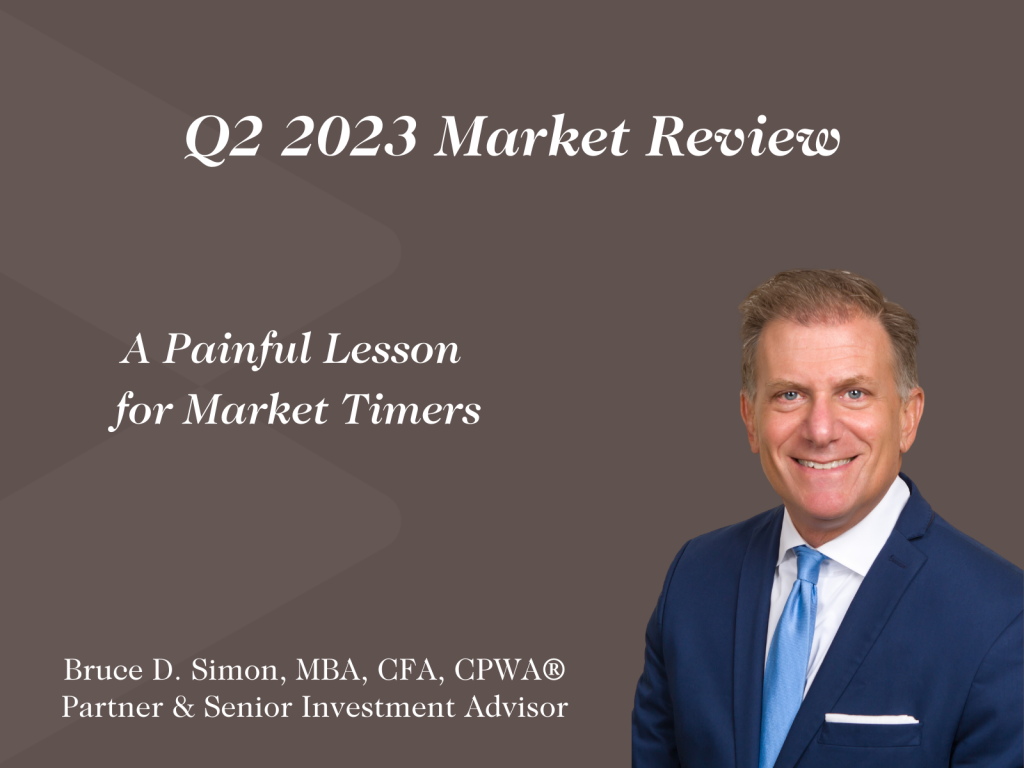Market Recap
If you follow the Wall Street strategists on CNBC or other financial news sources, you may recall many of them back in March forecasting an imminent and painful decline in stock prices. The logic seemed sound: turmoil was spreading through the banking system, the Fed was unequivocal on raising interest rates to squash inflation, and a recession seemed all but inevitable. Their advice: sell some of your stocks and put the proceeds on bonds or cash, and wait for the elusive “all-clear” signal to get back in.
If you followed this recommendation, you would have missed a 16% rally in the S&P 500 from its low in mid-March through the end of June. Such is the folly of trying to time the market by guessing the direction of stock prices in the short term, even when the news seems incontrovertibly bad.
On the strength of the second quarter rally, US equities regained their performance lead over their international counterparts as the S&P 500 posted a gain of 8.7% vs. a 3.0% gain in developed international stocks (MSCI EAFE) and just 0.9% for emerging market equities (MSCI Emerging Markets). Since the start of 2023, the S&P 500 is up a sparkling 16.9%, outpacing EAFE (+11.7%) and Emerging Markets (+4.9%). The outperformance of US equities reflects growing confidence in a less severe slowdown in economic activity in the US vs. Europe, the failure of China’s economy to reaccelerate after the lockdown was ended in December, and the notion that the Fed is closer to ending its rate-tightening cycle than other central banks around the world. Additionally, the hype surrounding artificial intelligence (AI) gave an additional lift to the technology-heavy US equity market.
Bond yields fluctuated in a narrow range in Q2 as investors grappled with a potential pause in the Fed’s monetary tightening activity and the still-present recession threat. Including a jump in late June, the bellwether 10-year US treasury note finished at a yield of 3.84% after beginning the quarter at 3.55%. The ongoing inversion of the yield curve supplied attractive returns in shorter-term fixed income securities. At quarter’s end, investors could lock in approximately 4.90% on two-year treasury notes, and almost 5.5% on 6-month bills. Money market funds were generating yields in the 4.5% range, a nice boost from the near-zero returns of the last decade.
Oil prices continued to fall in Q2, reflecting concerns about global growth. On a trailing one-year basis, the Bloomberg WTI Crude Index is down roughly 30%. Other real assets, including real estate investment trusts (REITs) and gold, also posted modest declines in Q2.
Outlook and Strategy
We have maintained for some time that if a recession did occur, it would likely be shorter and more shallow than in the past. Our thesis was based on the notion that although the US economy was likely to weaken, we were starting from a position of strength. Consumer balance sheets were strong, corporations had taken advantage of a long period of exceptionally low rates to lock in low borrowing costs, and generous fiscal stimulus programs enacted over the last few years would help to cushion any economic weakness. While it is certainly too early to declare victory, equity investors appear to be adopting this viewpoint. Our outlook (and our skepticism around short-term trading) supplied the confidence to stay close to our client’s investment targets during last year’s painful decline and this year’s subsequent recovery.
It is certainly possible that a few more Fed rate hikes may be the straw that finally breaks the camel’s back and plunges the US into a significant downturn. This year’s rally has once again stretched equity valuations, increasing the risk of a more significant market correction in the future.
But the surprising resiliency of the US economy in the first half of 2023 has persuaded many investors that the worst may be avoided. Economic data so far this year has been much better than feared. GDP growth has slowed but remained positive in the first quarter and was recently revised higher. Despite concerns about a big jump in the unemployment rate (and many high-profile announcements from tech companies that over-hired during the pandemic), job growth has remained strong. Consumer spending, the engine of the US economy, continued to expand even after adjusting for higher prices. While US manufacturing has contracted, it should begin to recover as government spending on infrastructure ramps up from the confusingly named Inflation Reduction Act.
It would be a mistake to conclude that a recession has been avoided rather than merely postponed. Given the consistent warning from the bond market (evidenced by the usually reliable inverted yield curve as a recession predictor) and the Fed’s stated priority of bringing inflation to heel even if it inflicts more economic pain, the odds of a downturn remain above average. While perhaps not irrational, the exuberance exhibited by the stock market in the first half will require a continuing stream of positive economic data for equities to move higher from here.
From a positioning standpoint, we remain largely in-line with client target allocations to equities. We’ve maintained an overweight allocation to US stocks along with a modest underweight to developed international equities and a neutral view of emerging markets. Our U.S. equity allocation also reflects a slight tilt toward small cap stocks, which have lagged in this year’s rally and appear quite inexpensive, both in absolute and relative terms. In real assets, we have a bias toward infrastructure stocks, an underweight in real estate, and no direct commodity exposure. The sharp backup in yields in the last year has improved the outlook for bonds, but we are awaiting a more attractive entry point before increasing our recommended allocation. We recently took steps to upgrade the quality of our bond portfolio by reducing the allocation to high yield debt, providing some cushion to fixed income investors against the possibility of a deteriorating credit environment. Credit spreads are paying you a “normal” amount against a backdrop of above-normal risk; our thought is that credit risk should command additional compensation.
About Bruce D. Simon, MBA, CFA, CPWA®
Bruce is a Partner & Senior Investment Advisor at the firm. In addition to working directly with a number of family clients, Bruce serves on Ballentine’s Investment Management Committee, which is responsible for the oversight of all of the investment activities for the firm.
This report is the confidential work product of Ballentine Partners. Unauthorized distribution of this material is strictly prohibited. The information in this report is deemed to be reliable. Some of the conclusions in this report are intended to be generalizations. The specific circumstances of an individual’s situation may require advice that is different from that reflected in this report. Furthermore, the advice reflected in this report is based on our opinion, and our opinion may change as new information becomes available. Nothing in this presentation should be construed as an offer to sell or a solicitation of an offer to buy any securities. You should read the prospectus or offering memo before making any investment. You are solely responsible for any decision to invest in a private offering. The investment recommendations contained in this document may not prove to be profitable, and the actual performance of any investment may not be as favorable as the expectations that are expressed in this document. There is no guarantee that the past performance of any investment will continue in the future.




